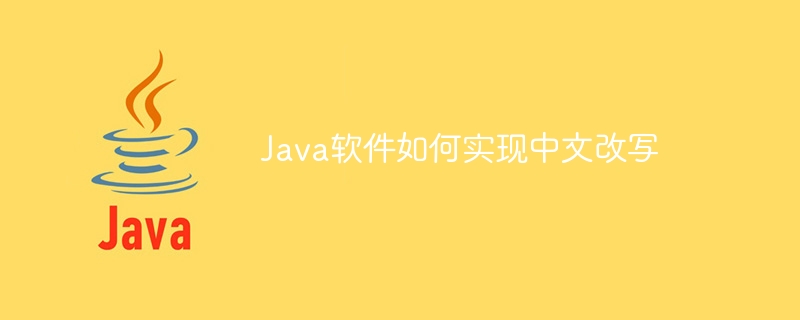What is the Java software method to implement Chinese rewriting?

How to implement Chinese rewriting in Java software
With the rapid development of the Internet and people's increasing demand for information, Chinese rewriting has become an important issue. Chinese rewriting refers to the semantic transformation of the original text so that the rewritten text has the same or similar semantics as the original text, but with different expressions. Chinese rewriting can be used in text enhancement, search engine optimization, information security and other fields.
You can use some open source libraries and algorithms to implement Chinese rewriting in Java. Below we will introduce a commonly used rule-based Chinese rewriting method and provide relevant code examples.
1. Rule-based Chinese rewriting method
The rule-based Chinese rewriting method is to replace specific words or phrases in the original text with target words or phrases by defining a series of rules, thereby Change the expression of the original text. Here we use a simple example to illustrate, rewriting "delicious" in the original text into "delicious".
- Create a rule set: We first define a rule set, which contains the vocabulary that needs to be rewritten and the corresponding target vocabulary.
Map<String, String> rules = new HashMap<>();
rules.put("好吃", "美味");- Implementing the rewriting method: Next, we implement a rewriting method that traverses the words in the original text and replaces them according to the set of rules.
public String rewrite(String text, Map<String, String> rules) {
for (Map.Entry<String, String> entry : rules.entrySet()) {
String origin = entry.getKey();
String target = entry.getValue();
text = text.replace(origin, target);
}
return text;
}- Call the rewrite method: Finally, we can call the rewrite method, pass in the original text and rule set, and get the rewritten text.
String originalText = "这家饭馆的菜好吃。"; String rewrittenText = rewrite(originalText, rules); System.out.println(rewrittenText); // 输出结果:这家饭馆的菜美味。
The above code example is just a simple example. The actual rule set may be very complex and needs to be designed and optimized according to specific application scenarios.
2. Other Chinese rewriting methods
In addition to the rule-based Chinese rewriting method, there are some other methods to achieve Chinese rewriting. For example, a machine learning algorithm can be used to train a model to convert a given original text into rewritten text. This method requires a large amount of training data and computing resources, and requires semantic understanding and generation of text.
In addition, you can also use open source natural language processing libraries, such as HanLP, LTP, etc., which provide some ready-made Chinese rewriting functions that can be used directly or for secondary development.
Summary:
This article introduces the rule-based method of implementing Chinese rewriting in Java and gives code examples. According to actual needs, basic Chinese rewriting functions can be implemented according to this method, and other rewriting methods can also be further explored. Chinese rewriting plays an important role in information processing and text analysis, and is of great significance for improving information efficiency and quality.
The above is the detailed content of What is the Java software method to implement Chinese rewriting?. For more information, please follow other related articles on the PHP Chinese website!

Hot AI Tools

Undresser.AI Undress
AI-powered app for creating realistic nude photos

AI Clothes Remover
Online AI tool for removing clothes from photos.

Undress AI Tool
Undress images for free

Clothoff.io
AI clothes remover

AI Hentai Generator
Generate AI Hentai for free.

Hot Article

Hot Tools

Notepad++7.3.1
Easy-to-use and free code editor

SublimeText3 Chinese version
Chinese version, very easy to use

Zend Studio 13.0.1
Powerful PHP integrated development environment

Dreamweaver CS6
Visual web development tools

SublimeText3 Mac version
God-level code editing software (SublimeText3)

Hot Topics
 1376
1376
 52
52
 How does Java's classloading mechanism work, including different classloaders and their delegation models?
Mar 17, 2025 pm 05:35 PM
How does Java's classloading mechanism work, including different classloaders and their delegation models?
Mar 17, 2025 pm 05:35 PM
Java's classloading involves loading, linking, and initializing classes using a hierarchical system with Bootstrap, Extension, and Application classloaders. The parent delegation model ensures core classes are loaded first, affecting custom class loa
 How do I implement multi-level caching in Java applications using libraries like Caffeine or Guava Cache?
Mar 17, 2025 pm 05:44 PM
How do I implement multi-level caching in Java applications using libraries like Caffeine or Guava Cache?
Mar 17, 2025 pm 05:44 PM
The article discusses implementing multi-level caching in Java using Caffeine and Guava Cache to enhance application performance. It covers setup, integration, and performance benefits, along with configuration and eviction policy management best pra
 How can I use JPA (Java Persistence API) for object-relational mapping with advanced features like caching and lazy loading?
Mar 17, 2025 pm 05:43 PM
How can I use JPA (Java Persistence API) for object-relational mapping with advanced features like caching and lazy loading?
Mar 17, 2025 pm 05:43 PM
The article discusses using JPA for object-relational mapping with advanced features like caching and lazy loading. It covers setup, entity mapping, and best practices for optimizing performance while highlighting potential pitfalls.[159 characters]
 How do I use Maven or Gradle for advanced Java project management, build automation, and dependency resolution?
Mar 17, 2025 pm 05:46 PM
How do I use Maven or Gradle for advanced Java project management, build automation, and dependency resolution?
Mar 17, 2025 pm 05:46 PM
The article discusses using Maven and Gradle for Java project management, build automation, and dependency resolution, comparing their approaches and optimization strategies.
 How do I create and use custom Java libraries (JAR files) with proper versioning and dependency management?
Mar 17, 2025 pm 05:45 PM
How do I create and use custom Java libraries (JAR files) with proper versioning and dependency management?
Mar 17, 2025 pm 05:45 PM
The article discusses creating and using custom Java libraries (JAR files) with proper versioning and dependency management, using tools like Maven and Gradle.




